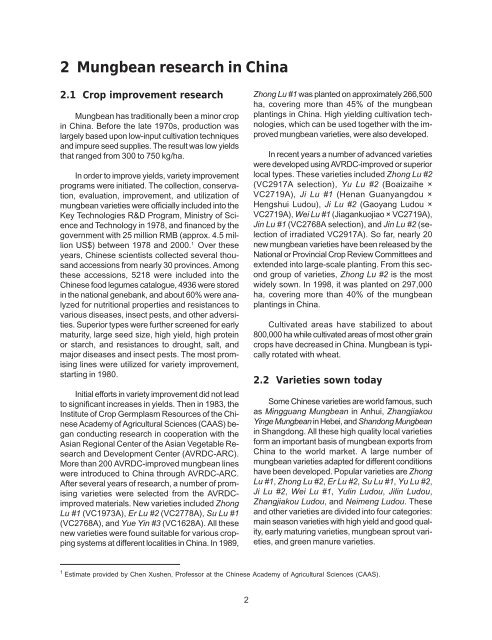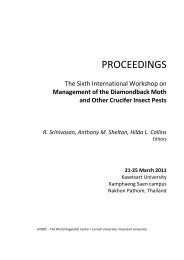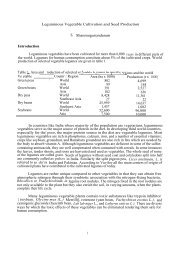The Impact of Mungbean Research in China
The Impact of Mungbean Research in China
The Impact of Mungbean Research in China
Create successful ePaper yourself
Turn your PDF publications into a flip-book with our unique Google optimized e-Paper software.
2 <strong>Mungbean</strong> research <strong>in</strong> Ch<strong>in</strong>a2.1 Crop improvement research<strong>Mungbean</strong> has traditionally been a m<strong>in</strong>or crop<strong>in</strong> Ch<strong>in</strong>a. Before the late 1970s, production waslargely based upon low-<strong>in</strong>put cultivation techniquesand impure seed supplies. <strong>The</strong> result was low yieldsthat ranged from 300 to 750 kg/ha.In order to improve yields, variety improvementprograms were <strong>in</strong>itiated. <strong>The</strong> collection, conservation,evaluation, improvement, and utilization <strong>of</strong>mungbean varieties were <strong>of</strong>ficially <strong>in</strong>cluded <strong>in</strong>to theKey Technologies R&D Program, M<strong>in</strong>istry <strong>of</strong> Scienceand Technology <strong>in</strong> 1978, and f<strong>in</strong>anced by thegovernment with 25 million RMB (approx. 4.5 millionUS$) between 1978 and 2000. 1 Over theseyears, Ch<strong>in</strong>ese scientists collected several thousandaccessions from nearly 30 prov<strong>in</strong>ces. Amongthese accessions, 5218 were <strong>in</strong>cluded <strong>in</strong>to theCh<strong>in</strong>ese food legumes catalogue, 4936 were stored<strong>in</strong> the national genebank, and about 60% were analyzedfor nutritional properties and resistances tovarious diseases, <strong>in</strong>sect pests, and other adversities.Superior types were further screened for earlymaturity, large seed size, high yield, high prote<strong>in</strong>or starch, and resistances to drought, salt, andmajor diseases and <strong>in</strong>sect pests. <strong>The</strong> most promis<strong>in</strong>gl<strong>in</strong>es were utilized for variety improvement,start<strong>in</strong>g <strong>in</strong> 1980.Initial efforts <strong>in</strong> variety improvement did not leadto significant <strong>in</strong>creases <strong>in</strong> yields. <strong>The</strong>n <strong>in</strong> 1983, theInstitute <strong>of</strong> Crop Germplasm Resources <strong>of</strong> the Ch<strong>in</strong>eseAcademy <strong>of</strong> Agricultural Sciences (CAAS) beganconduct<strong>in</strong>g research <strong>in</strong> cooperation with theAsian Regional Center <strong>of</strong> the Asian Vegetable <strong>Research</strong>and Development Center (AVRDC-ARC).More than 200 AVRDC-improved mungbean l<strong>in</strong>eswere <strong>in</strong>troduced to Ch<strong>in</strong>a through AVRDC-ARC.After several years <strong>of</strong> research, a number <strong>of</strong> promis<strong>in</strong>gvarieties were selected from the AVRDCimprovedmaterials. New varieties <strong>in</strong>cluded ZhongLu #1 (VC1973A), Er Lu #2 (VC2778A), Su Lu #1(VC2768A), and Yue Y<strong>in</strong> #3 (VC1628A). All thesenew varieties were found suitable for various cropp<strong>in</strong>gsystems at different localities <strong>in</strong> Ch<strong>in</strong>a. In 1989,Zhong Lu #1 was planted on approximately 266,500ha, cover<strong>in</strong>g more than 45% <strong>of</strong> the mungbeanplant<strong>in</strong>gs <strong>in</strong> Ch<strong>in</strong>a. High yield<strong>in</strong>g cultivation technologies,which can be used together with the improvedmungbean varieties, were also developed.In recent years a number <strong>of</strong> advanced varietieswere developed us<strong>in</strong>g AVRDC-improved or superiorlocal types. <strong>The</strong>se varieties <strong>in</strong>cluded Zhong Lu #2(VC2917A selection), Yu Lu #2 (Boaizaihe ×VC2719A), Ji Lu #1 (Henan Guanyangdou ×Hengshui Ludou), Ji Lu #2 (Gaoyang Ludou ×VC2719A), Wei Lu #1 (Jiagankuojiao × VC2719A),J<strong>in</strong> Lu #1 (VC2768A selection), and J<strong>in</strong> Lu #2 (selection<strong>of</strong> irradiated VC2917A). So far, nearly 20new mungbean varieties have been released by theNational or Prov<strong>in</strong>cial Crop Review Committees andextended <strong>in</strong>to large-scale plant<strong>in</strong>g. From this secondgroup <strong>of</strong> varieties, Zhong Lu #2 is the mostwidely sown. In 1998, it was planted on 297,000ha, cover<strong>in</strong>g more than 40% <strong>of</strong> the mungbeanplant<strong>in</strong>gs <strong>in</strong> Ch<strong>in</strong>a.Cultivated areas have stabilized to about800,000 ha while cultivated areas <strong>of</strong> most other gra<strong>in</strong>crops have decreased <strong>in</strong> Ch<strong>in</strong>a. <strong>Mungbean</strong> is typicallyrotated with wheat.2.2 Varieties sown todaySome Ch<strong>in</strong>ese varieties are world famous, suchas M<strong>in</strong>gguang <strong>Mungbean</strong> <strong>in</strong> Anhui, ZhangjiakouY<strong>in</strong>ge <strong>Mungbean</strong> <strong>in</strong> Hebei, and Shandong <strong>Mungbean</strong><strong>in</strong> Shangdong. All these high quality local varietiesform an important basis <strong>of</strong> mungbean exports fromCh<strong>in</strong>a to the world market. A large number <strong>of</strong>mungbean varieties adapted for different conditionshave been developed. Popular varieties are ZhongLu #1, Zhong Lu #2, Er Lu #2, Su Lu #1, Yu Lu #2,Ji Lu #2, Wei Lu #1, Yul<strong>in</strong> Ludou, Jil<strong>in</strong> Ludou,Zhangjiakou Ludou, and Neimeng Ludou. <strong>The</strong>seand other varieties are divided <strong>in</strong>to four categories:ma<strong>in</strong> season varieties with high yield and good quality,early matur<strong>in</strong>g varieties, mungbean sprout varieties,and green manure varieties.1Estimate provided by Chen Xushen, Pr<strong>of</strong>essor at the Ch<strong>in</strong>ese Academy <strong>of</strong> Agricultural Sciences (CAAS).2
















